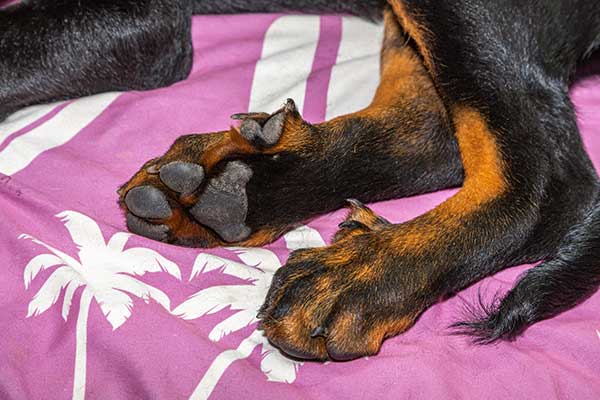Most dogs are born with dew claws on their front legs and a few on their hind legs too. Dewclaw is an extra toe located on the leg of a dog that doesn’t touch the ground when he is standing.
As an attentive canine owner, you’ve probably noticed that an extra toe is popping out on your pooch’s leg, separate from those on the paw pad.
It is a completely natural toe with three bones, two joints and a nail just like every other digit on a dog’s paw pad. They appear on the front legs of most dogs and can be abnormal when they emerge on the hind legs of your pup.
Why Do Dogs Have Dew Claws?
Dewclaws help to stabilize the wrist joint when dogs run at high speeds or on slippery ground. They also help your pooch climb trees and hold objects.
For dog breeds like the Beauceron, it is necessary for sheep herding and navigating snowy terrain.
Dewclaws that are only attached by the skin are not as helpful. This is because they tend to tangle and can catch onto things which can cause pain and injury to your pup. These types of dewclaws do not serve any real purpose.
Why Do The Dewclaws On A Dog’s Paw Break And Split?
Bruises and splits on dew claws can be caused by wrong positioning when your dog jumps or plays. Dogs who don’t walk or run enough are also likely to have an injured paw. Without exercise or daily activities, the dew claw grows too long into a hook shape, which can get stuck on anything.
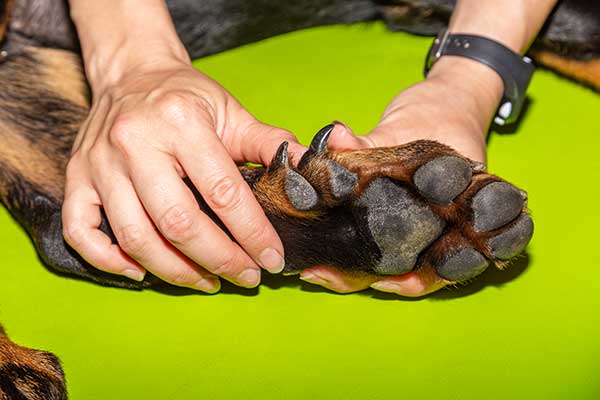
Is It Recommended To Remove Dewclaws?
There is nothing wrong with removing a dewclaw. However, it’s not always recommended because of the possible risk to pup’s health.
One of the risks are the hazard of a disease and scarring at the expelled dewclaw location. In a few cases, regrowth of the nail is possible. Removal of an extra toe could also be the root of a long lasting health problem in the future.
Without a front dewclaw, there appears to be a better likelihood that the carpal tendons can extend and tear. Afterwards, there would be laxity and severe joint pain as your pup grows.
To remove a dewclaw is, however, the personal choice of a dog owner.
Removal of a dewclaw is usually done during the 3rd to 5th day after birth. After this period, amputation is considered and is done by a vet, complete with anesthesia. Even after the surgery, there’s the risk of an infection setting in. You shouldn’t put your dog through such stress except you have a proper reason for removing their dewclaws.
Before thinking of removal, you must also consider your dog’s breed, daily activities ( i.e they could be farm dogs, service dogs, police dogs, etc.), and the environment where they live.
Canines who live outdoors are often declawed to prevent bruises and wounds. While the ones who stay more at home are best left with all their toes.
How To Trim A Dog’s Dew Claws
Trimming your dog’s dew claw is very important. The dewclaw is not worn by exercises like walks or running as it barely touches the ground, so it has to be trimmed every three to four weeks.
Allowing the nail to grow too long can cause it to get caught on surfaces and objects and lead to serious lesions.
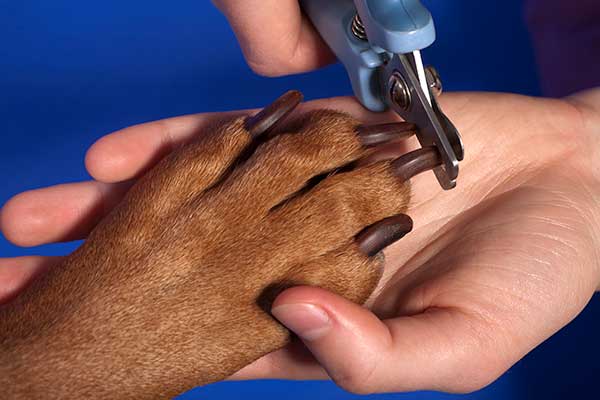
Leaving it untrimmed can also make the nail grow into soft tissue. You need to trim the dewclaw as frequently and with as much attention as you give your dog’s other nails.
Cutting a dew claw is also very easy. You can do them while trimming the rest of their nails. Owners can trim their pup’s extra toes by following these simple steps:
1. Make your dog comfortable. You can do this by helping your dog get used to the trimming tools you choose to engage. Allow your dog to sniff at it. Keep the tools in his view. Also consider calming him down with soothing gestures and treats.
2. Find the dewclaw. The dewclaw isn’t hard to find and is usually on the inner part of your dog’s legs. If your dog doesn’t have one, it means it had already been cut off when they were still puppies.
3. Check if the dew claw is healthy. Some of them may be already injured, especially if it’s the first time you’re trimming it. Dew Claws are prone to split and break so you must check them regularly for cracks, chipping, or signs of a tear. A healthy dewclaw is colored just like other nails and looks smooth. There may be color variations but if there is a red or brown discoloration inside the nail, it could be an injury and should be taken note of.
4. Select the right tools. Having a proper dog nail grinder or clippers is important in trimming the dewclaw. It helps you have better control over the cutting process and reduce the risk of hurting your pet.
5. Identify the quick. The dew claw also has a quick, which is a blood vessel inside the nail of a dog. Cutting or grinding into the quick can be painful and cause your dog pain. It is relatively easy to spot if the nail on the extra toe is clear. It looks like a darker-colored ring in the middle of the dog’s nail.
6. Trim the nail. If you’re using clippers, cut in the opposite direction of the quick and if you’re using a grinder, make sure to grind off a little at a time and give your dog treats along the way. Cut until the nail is 2 millimeters away from your dog’s paw.
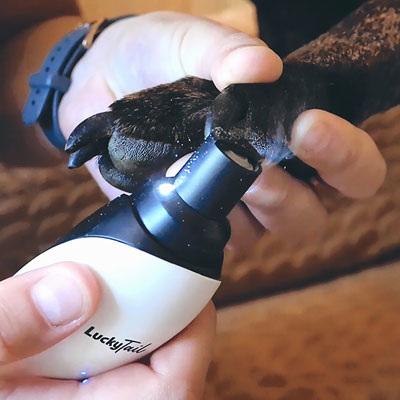
How To Find Quick On Black Dog Nails?
In dogs with dark or black nails, the quick is not so easily seen, so you have to make sure to trim little bits of the nail and stop cutting when you see a darker colored circle in the middle of the nail.
Make sure to also stop, if your pet reacts in pain or at the first sign of blood. If you cut into the quick by accident, you can use styptic powder or cornstarch to stop the bleeding.
After identifying the quick, use that to measure the right length to cut away. A good length is usually 2 millimeters away from the paw pad.
How To Cut An Overgrown Dew Claw
You should start close to the tip of your dog’s nail and cut away small bits at a time until the nail is no longer curled. You stop clipping once you get close to the quick of the nail to avoid cutting into it. While trimming, it’s also good that you don’t cut the dog’s nails too short. You can also use a nail grinder to smoothen the nail.
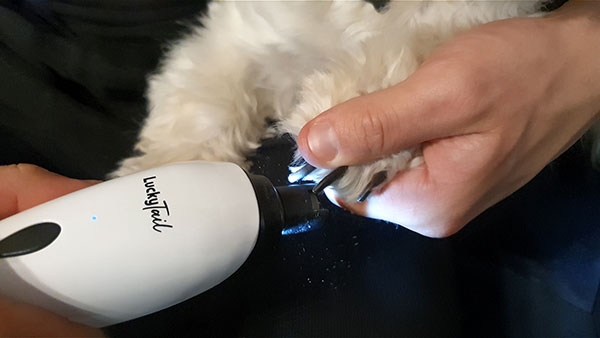
Conclusion
Dewclaws are natural and shouldn’t be a cause for alarm. Many breeders tend to cut them off before selling the puppies. However, keeping them, especially the ones on the front legs of the dog, is always a good decision.
Dewclaws, like other nails, also need to be paid attention regularly. The hind dewclaws, especially, may become troublesome if neglected. Trimming and grooming should be done to ensure your dog’s health and happiness.

